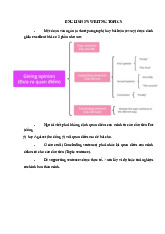



Preview text:
lOMoARcPSD|50713028 NGỮ ÂM THỰC HÀNH UNIT 1: 1.What does phonetics study?
Phonetics is the study of the production and perception of human speech sounds.
2.What are the branches of phonetics? (trắc nghiệm)
Phonetics in itself has been divided into three sub-branches:
Acoutics phonetics is the study of the physical properties of the sounds that are made.
Auditory phonetics is the study of how sounds are perceived as incoming sound signals.
Articulatory phonetics is the study of the physical gestures of sound production.
3.How are speech sounds articulated?
Speech is produced by the controlled movement of air through the throat, mouth and nose (the vocal tract)
4.Lists the articulators (speech organ) that are employed in the production of speech sounds? Lips Teeth Tongue Hard Palate Soft palate (velum) Alveolar ridge Uvula Glottis Pharynx Oral cavity Nasal cavity
5.How are speech organs classified? They are divided into
Active articulators does all or most of the movement when a speech sound is made. It is usually the lower
lip or a part of the tongue, because the tongue and the lower jaw are free moving
Passive articulators does little of no movement. It is the part of the place of articulation where the active
articulator presses against: usually the upper jaw, upper teeth, roof of the mouth, or pharynx
6.How many parts doeas a tongue have?
The tongue has 5 parts namely tip, blande, front, back, and root. lOMoARcPSD|50713028 UNIT 2
1.How many phonetics symbols are there in English?
There are forty-four phonetics symbols in English
2.How are speech sounds divided?
They are divided into vowels and consonants 3.How is a vowel articulated?
A vowel is articulated with the air from the lungs passing through the vibrating glottis anf the vocal tract without any interuption
4.What characteristics are employed to describe the production of vowel sounds?
Tongue height, frontness, lip shape, and duration
5.How many monophthongs and diphthongs are there in English? Explain about them in more detail?
There are twelve monophthongs in English
/i:/ is a long, high, front, unrounded vowel. …
There are eight diphthongs in English. /ei/ …
6. Describe the process of consonant production
Consonat sounds are produced with some degree of contriction in the vocal tract.
7.How are consonants classified?
They are classified into three categories (dimensions)
Voicing – The focal folds may be held against each other at just the right tension so that the air flowing
past them from the lungs will cause them to vibrate against each other. This process is voicing
Voiced sounds are made with vocal fold vibration
Voiceless sounds are made without vocal fold vibration
Place of articulation – where sounds are produced
Manner of articulation – how sounds are made/ produced UNIT 3 1.What are monophthongs?
Monophthongs is a simple or pure vowel articulated without any obstacles in the vocal tract.
2.Describe how English monophthongs are produced? lOMoARcPSD|50713028
English monophthongs are articulated without any obstacles in the vocal tract.
3.How are monophthongs divided?
They are divided into short vowels and long vowels
4.Draw the diagram of the tongue positions of English monophthongs 5.What are diphthongs?
Diphthongs is a simple or pure vowel articulated without any ocstacles
6.Describe how English monophthongs are produced?
English monophthongs are articulated without any obstacles in the vocal
7.How are monophthongs divided?
They are divided into short vowels and long vowels
8.Draw the diagram of the tongue positions of the English monophthongs 9.What are the triphthongs?
Triphthongs involves two pure vowels or monothongs, with one vowel gliding into another
10.Describe how English triphthongs are produced? lOMoARcPSD|50713028
English triphthongs are produced by combining three pure vowels or monothongs, in whichs the first one
one glides into the second one, and then the second one preceded by the first one glides into the third one.
11.Draw the diagram of the tongue positions of the English triphphthongs?
12.What’s it meant by place of articulation?
The location at which two speech organs approach or come together in producing a speech sound
13. What places of articulations are there?
There are bilabiar, labiodental, glottal, dental, alveolar, palatar, velar.
14.How is a dental consonant created?
A dental consonant is a consonant articulated with the tongue against the upper teeth, such as /θ/, /ð/. UNIT 4
1. What’s it meant by manner of articulation?
In articulatory phonetics, the manner of articulation is the configuration and interaction of the articulators
(speech organs such as the tongue, lips, and palate) when making a speech sound
2. What manners of articulation are there?
The five manners of articulation used for consonant sounds in the English language are: plosive, fricative,
affricate, nasal and lateral approximant.
3. How is a nasal consonant created?
A nasal sound is produced with a lowered velum, allowing air to flow through the nose
4. what is the process of voicing in phonetics?
Voicing can refer to the articulatory process in which the vocal folds vibrate, its primary use in phonetics
to describe phonemes, which are particular speech sounds.
5. What are the voiced sounds in phonetics?
In phonetics, 'voiced' refers to a sound produced with the vocal folds vibrating, causing audible
vibrations. It contrasts with 'voiceless' sounds, which occur when the vocal folds remain open without
vibrating. Examples of voiced sounds include 'b', 'd', and 'g', while 'p', 't', and 'k' are voiceless




